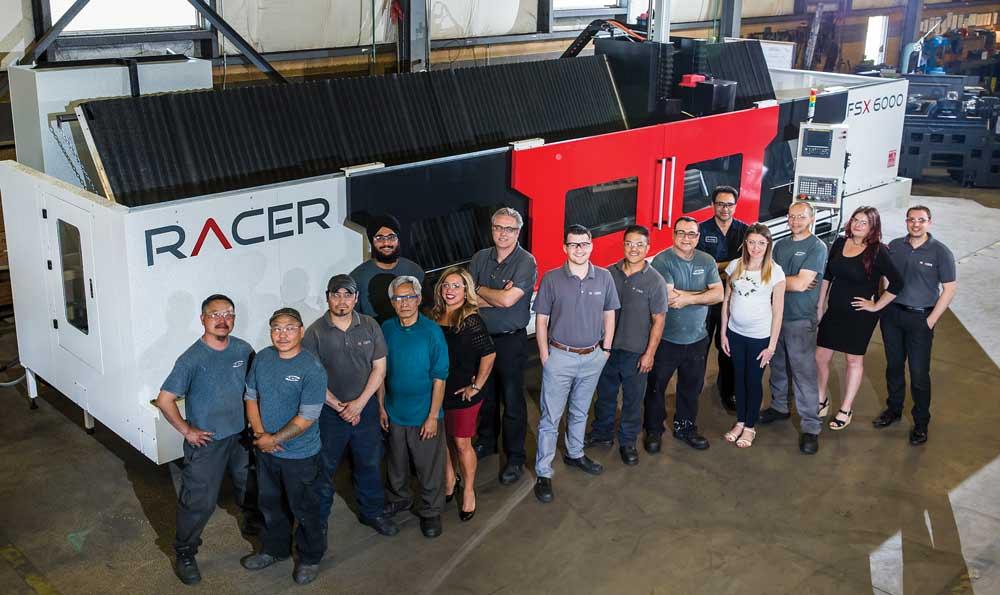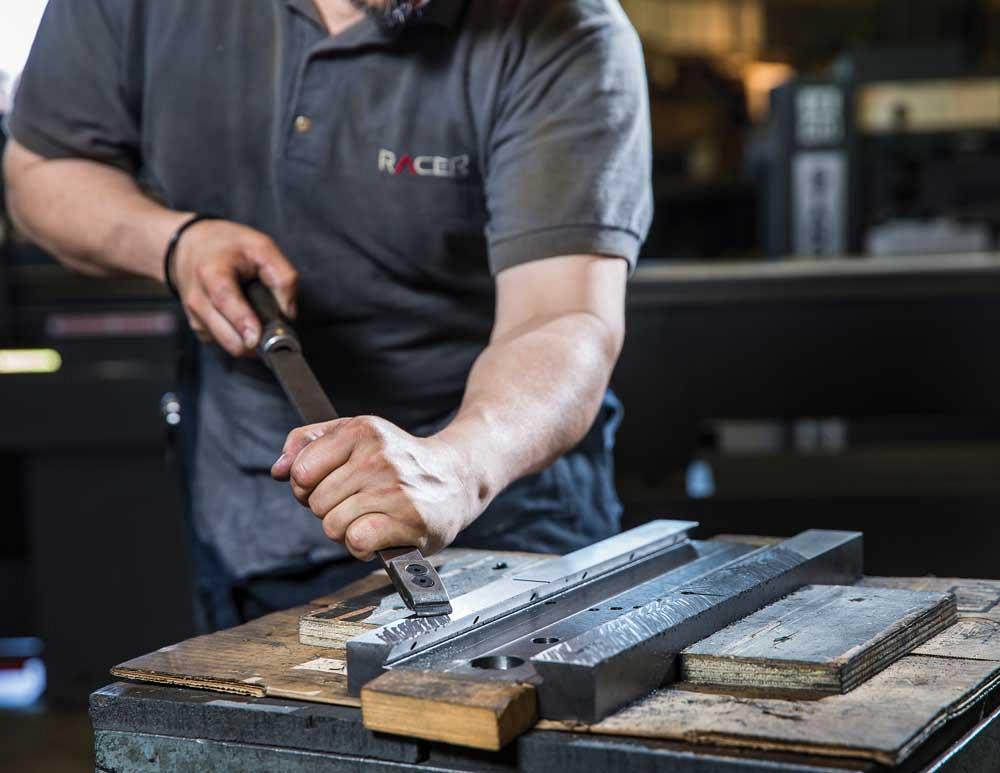Editor
- FMA
- The Fabricator
- FABTECH
- Canadian Metalworking
Canadian machine tool builder uses Old World craftsmanship to create new technology
It's a race to the top
- By Joe Thompson
- September 6, 2018
- Article
- Made In Canada

The staff of Racer Machinery Intl. stand in front of a 6-m multi-axis mill/turning centre that is ready to be shipped from the company's Cambridge, Ont., facility.
In Cambridge, Ont., across the street from a well-known automotive manufacturer with a production line full of robots, a worker patiently hand-scrapes lathe ways. He’s in the shop of Racer Machinery Intl., and he’s very good at his job.
“Our headstock is hand-scraped into position, and it sits on the same V as the carriage does. No machining process can produce this same kind of finish and fit that hand scraping does,” explained Alex Vojinovich, the company’s COO. “That’s why we do it this way. It takes time, it takes effort, but it’s the right way to produce that part.”
The ways are for a Standard Modern™ lathe, a name that is very recognizable to metal manufacturers. First manufactured in 1931, these engine lathes are mainly built for the North American market and are used extensively by both military and educational institutions. Racer estimates that there are more than 17,000 Standard Modern installations in North America.
Vojinovich and his brother, Igor, handle the day-to-day operations of this machine tool builder, one of only a handful left in the entire country. The vast majority of parts for the company’s equipment are built in-house, which keeps the company’s machine shop busy. Tailstocks, chucks, gears and gearboxes, and spindles are all SKUs at Racer.
The dedication to doing as much work as possible in-house started with Alex and Igor’s father, Don, who started the company as Progress Machine in 1983 before forming Racer Machinery in 1990.
“The same processes that our customers use in their day-to-day operations, we use here in the shop to produce tools for them,” added Vojinovich. “We turn spindles, machine headstocks from castings, and do the gear hobbing for our own gearboxes. We try to do as much as we possibly can with our own machines and know-how.”
Racer’s beginning
The early years at Racer are common to many start-ups. It could have just as easily been another type of business, but Don knew machine tools from his time working in Europe, and so machine tools it was.
“Racer was founded by my father and mother and, basically, they started it because Dad had a passion for machine tools,” said Vojinovich. “That's what he grew up doing and what he was trained for in Europe.”
During the early years, the company was a very service-oriented shop. Don did a lot of rebuilds and retrofits, and then, finally, in 1990, he started building his own CNC machines, a tradition that still is in place today.
“He saw demand for machines with PC-based controllers, so that's what he was working on in the early days,” said Vojinovich. “They made machines that had PC-based controls and everything took off from there. There was a learning curve, but we kept moving forward, kept building machines, and everything progressed to where we are today.”

Hand-scraping the headstock into position guarantees that it will sit in the same V as the carriage.
It’s quite a leap to go from repairing spindles to building a whole machining platform, but over the course of time, Racer-branded multi-axis lathes became a reality.
“Dad’s dream was always to build everything. So, any opportunity he got, he tried to seize it. We started building small machines in the back in 2000, and now our machines have evolved, and we now manufacture larger equipment,” said Vojinovich.
This transitional phase of the business has moved forward with speed in the last five years. It started with a refocusing of the business and engaging in markets in which the company can thrive. While not being able to compete on the world stage by producing smaller equipment (machines with beds 1 metre or less), the company focused its efforts on producing large CNC turning centres. It also focuses on other core products, such as the Standard Modern lathes, machining centres, and saws.
Today Racer Machinery manufactures and sells turnkey Racer brand CNC machine tools; Standard Modern engine lathes, which it purchased in 2014; and E-R Maier™ industrial saws, which the company purchased in 2008.
“To the best of my knowledge, we're the only remaining machine tool maker in all of North America that still makes conventional engine lathes,” said Vojinovich. “That's kind of a unique thing on its own, but now we can offer a pretty full product range from the small lathes all the way to these multi-cell machines. Standard Modern, because they’ve been around since 1931, are kind of a legacy machine. What we're trying to do with them is resurrect the brand. Our goal is to basically bring it back to its glory days. With the Racer machinery we are trying to establish a new brand in the marketplace.”
With brother Igor running the financial and marketing side of the business, Alex focuses on sales, engineering, and production.
“It's good to have the multiple generations and family members working together because there's things that my dad brings to the table and skills my brother brings to the table that I don’t have. It makes it easier to work knowing that you have that kind of support,” said Vojinovich.
One of the items left on the to-do list for the second-generation group at Racer is machine and corporate branding. With well-known brands as part of the product offering, he sees it as time to step up that part of the business.
“We need to get the Racer name out in front of people, so we get to the point where people see the name and know exactly what we do,” said Vojinovich.
New machine bed technology
Part of that branding phase involves getting the word out about the company’s Phantom Machine Technology™.
Phantom Machine Technology is a patented machine construction process that, according to Vojinovich, allows for production methods to be performed faster while reducing noise in the production area. The company basically has redesigned the machine’s base, eliminating most castings and replacing them with steel. It’s a feature of the company’s Racer-branded equipment.
The Racer machine
Racer machines are not standard, out-of-the-box machines, so various lengths and options are available for customization.
“These are not exactly catalogue items,” explained Vujinovich. “If you're looking for a machine that starts at 5 metres on the X axis and goes up from there, then this is where we enter the market. Right now we have a 6-metre, multi-axis lathe being built in the shop; the one after that is 8 metres. The ability to create a machine of that length literally is our biggest differentiator.”
While there is obviously a pride in quality evident at the shop, the company also is trying to differentiate itself by producing made-to-order equipment with fast turnaround times.
For some builds the company has part inventory on hand to complete the project, but for other builds, it creates a lot of custom machine parts.
Every step gets checked and signed off on before the build continues, too.
“There’s a process to these builds, and every step of the way there’s verification,” said Vojinovich. “I would call the mid-point of the build the critical point. You have so much work into it at that point that you’d better be perfect from that point on.”
All of this work happens in the company’s 22,000-square-foot facility with only 30 employees.
“You know, considering what we do, we’re a fairly small group,” said Vojinovich, adding that the majority of the staff are production workers, with rest being office staff, sales, and engineering.
In a small shop having a deep skill-set is important, and Racer’s production staff are proficient in multiple operations and assembly. However, the most important skills the company looks for—loyalty, dedication, and a willingness to learn—can’t be taught in school or picked up on the shop floor.

A worker assembles a feedbox in Racer's machine shop. Gear hobbing is just one of many machining processes that takes place on the shop floor.
“All the rest are teachable skills,” he said. “If you're applying for machinist job, that should be your core skill. Things that we’ll look for, aside from the core skills, are more social skills, like how you interact with people, how well you know your job, and how proactive are you. It's more about who they are than what they know. You can hone those other skills.”
In-house production
Keeping up to date with new machining technology and methodologies keeps production on track at Racer. The company continually examines every process and tool to see if there is a better or newer way to perform key tasks.
“New insert technology gives us the ability to cut dry. That’s an evolution that we implemented in the shop when a new method became available,” said Vojinovich. “Tooling technology has come so far recently that we no longer cut with coolant if we don’t have to. We found that, in our machining processes, cutting with coolant created microfractures [in the tool] because of thermal shock. It's also so much cleaner, especially when we are machining a casting. The guys can just vacuum and sweep up the chips; they are not stuck on everything. While we still use coolants for processes like gear hobbing, in areas where I can I avoid using them, I do.”
Many things in the shop are run with this minimalist approach.
“Between continual improvement efforts and minimizing waste, we can really affect the quality of the builds and the price that we are able to put the machine out for,” he said.
The future: a dealer network
The next step in the company’s evolution will be to establish a dealer network to sell Racer equipment around the world.
“That will be a big step for us,” said Vojinovich. “Having … machines on display floors around the world will enable us to increase the number of machines we produce per year and have, hopefully, some stability in the orders coming in.”
Editor Joe Thompson can be reached at jthompson@canadianmetalworking.com.
Racer Machinery Intl., www.racermachinery.com
About the Author

Joe Thompson
416-1154 Warden Avenue
Toronto, M1R 0A1 Canada
905-315-8226
Joe Thompson has been covering the Canadian manufacturing sector for more than two decades. He is responsible for the day-to-day editorial direction of the magazine, providing a uniquely Canadian look at the world of metal manufacturing.
An award-winning writer and graduate of the Sheridan College journalism program, he has published articles worldwide in a variety of industries, including manufacturing, pharmaceutical, medical, infrastructure, and entertainment.
Related Companies
subscribe now


Keep up to date with the latest news, events, and technology for all things metal from our pair of monthly magazines written specifically for Canadian manufacturers!
Start Your Free Subscription- Trending Articles
Automating additive manufacturing

Sustainability Analyzer Tool helps users measure and reduce carbon footprint

CTMA launches another round of Career-Ready program

Sandvik Coromant hosts workforce development event empowering young women in manufacturing

GF Machining Solutions names managing director and head of market region North and Central Americas

- Industry Events
MME Winnipeg
- April 30, 2024
- Winnipeg, ON Canada
CTMA Economic Uncertainty: Helping You Navigate Windsor Seminar
- April 30, 2024
- Windsor, ON Canada
CTMA Economic Uncertainty: Helping You Navigate Kitchener Seminar
- May 2, 2024
- Kitchener, ON Canada
Automate 2024
- May 6 - 9, 2024
- Chicago, IL
ANCA Open House
- May 7 - 8, 2024
- Wixom, MI

















